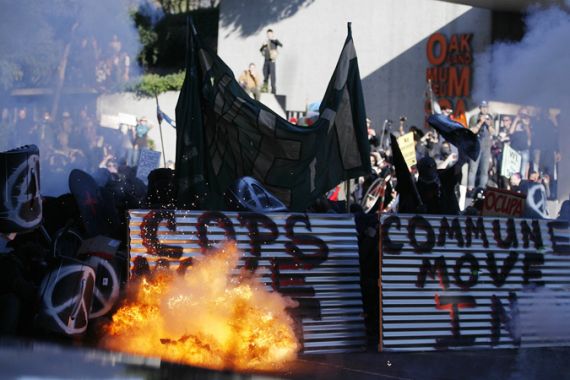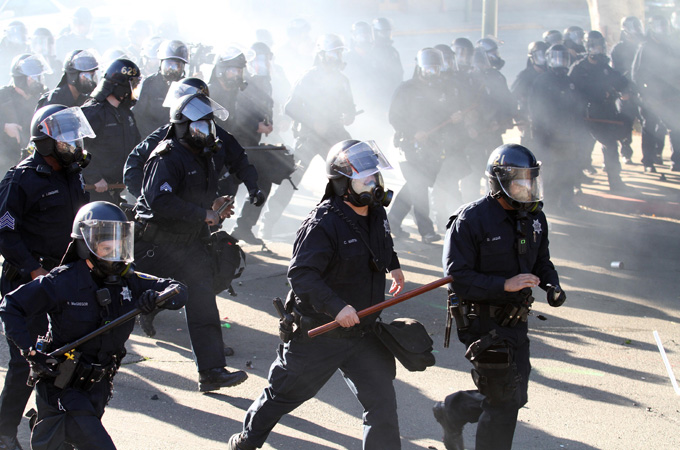Why Occupy Oakland keeps capturing headlines
A local activist explains why the Occupy movement is focusing on challenging police abuses in the city.

 |
| Police in Oakland have a history of brutal repression and wrongdoing, which has incited the ire of local activists [EPA] |
Oakland, CA – The streets of Oakland, a California city of about 400,000, became a battle ground again on Saturday, as police showed excessive force in their response to Occupy Oakland demonstrations. Around 400 protesters were arrested, and many more, including the elderly, children, and some unwitting passersby, were tear-gassed and injured during the course of the first day of Occupy Oakland’s Move-In Weekend and Rise Up Festival.
The day began with a march from the city hall plaza to a location chosen to become Occupy Oakland’s new community centre and home, the Kaiser Convention Center – a 215,000-square-foot building that has been empty for nearly six years. The building is publicly-owned, meaning that it should not be unreasonable for its use to be determined by members of the public. Occupy Oakland intended to repurpose the abandoned building for the good of the local community, serving as a place for general assemblies, housing, offices, events, meetings, classes, workshops, and the like.
Things did not go as planned as police surrounded the building, preventing protesters from coming near. As the march continued, police used tear gas to disperse the crowd, rushing with batons and making numerous arrests. This was only the first in a series of conflicts that lasted until midnight.
What we learned from Saturday’s events is more of what we already knew: The resources and institutions meant to work for those of us in the US are inaccessible, even becoming entities to be used against the people. The police are not hired to protect and serve the citizenry but to distract, beat, and stifle discontent.
Following this show of force by the Oakland Police Department (OPD), Occupy locations across the country organised events and marches to stand in solidarity, showing that with every show of force, Occupy will only become stronger as each time the authorities expose themselves further.
They, like the emperor who has no clothes, are bent on keeping power and exerting control by squashing the truth.
Consider the OPD’s numerous violations against the people of Oakland, spanning back long before Occupy Oakland ever pitched a tent. These violations are what caused OPD to come under scrutiny by the federal Department of Justice – who have placed watchdog Robert Warshaw as overseer of every decision made by the department – and what now potentially puts the OPD just weeks away from federal receivership. That would mean a complete takeover by the federal government.
Over a decade of abuse
In 2000, rookie Oakland police officer Keith Batt caused a stir when he blew the whistle on four fellow officers, Jude Siapno, Matthew Hornung, Francisco “Frank” Vazquez, and Clarence “Chuck” Mabanag, under whom Batt was training. Batt accused the four, who were later given the infamous name the Oakland “Riders”, of kidnapping, making false arrests, beating arrestees, falsifying police reports, and forcing Batt to help them cover up their crimes.
At the time, the Riders were some of the most popular and respected officers on the force, believed to have made a substantial number of drug and weapons busts. In reality, their success was the result of violence, corruption, and conspiracy, Batt said.
Three of the officers were charged with multiple felonies. Besides Batt, eight witnesses, all African-American men who had been arrested by the four, testified against the Riders. They all claimed to have been beaten and some to having drugs planted on them during their arrests. During the trial, Batt corroborated their stories, describing how one man was pepper-sprayed and beaten before being driven under an overpass, pulled out of the cop cruiser, and beaten further by two of the officers, how another was choked by one of the officers, and how he was forced to lie about everything.
Somehow, a jury (suburban, mostly white with no blacks) failed to convict the officers, who maintained their innocence throughout. Were they innocent? Considering the volume of witnesses, a fellow cop willing to testify, the ensuing federal investigation of the entire department, and the flight of the “ringleader” of the group, Vazquez, out of the country when the allegations were first made (he is still a fugitive): You tell us.
In the end, all four of the Riders walked free, and two of them asked for their jobs back.
|
Numbers of those who have been killed by Oakland police may be impossible to know, let alone those who have been beaten and unlawfully arrested. That doesn’t mean those stories don’t exist. |
One of the cases made by the defence was that Keith Batt was a “naive rookie with little understanding of the ways of an urban police department fighting a deadly drug war”. In the words of one of the Rider’s defense attorney, Michael Rains, “You don’t send choirboys out to West Oakland to get rid of drug dealers.” No, of course not. You send thugs.
It is notable that Rains more recently defended Johannes Mehserle, a police officer who was caught on camera by numerous New Years party-goers, shooting Oscar Grant, a 22-year-old African-American and father, at point-blank range while Grant was being handcuffed and lying on his belly on January 1, 2009, in Oakland.
When videos of the incident emerged, Oakland saw numerous rebellious protests and riots. Police responded with heavy handed tactics including numerous uses of tear gas, collaboration with the FBI and US Secret Service, and a mass arrest of 148 people. Mehserle was later convicted of involuntary manslaughter by a southern California jury and served the shortest possible sentence.
Numbers of those who have been killed by Oakland police may be impossible to know, let alone those who have been beaten and unlawfully arrested. That doesn’t mean those stories don’t exist.
With the federal government’s ongoing investigations of OPD, it is probably safe to assume that their own internal affairs department cannot be trusted. It is also notable that the 2009 head of OPD Internal Affairs, Captain Edward Poulson, became subject to an FBI probe after information resurfaced that he badly beat up a man, Jerry Amaro, nine years before, causing his death a month later. Not only did Poulson lie about the incident, but he ordered his subordinates to do the same. When internal affairs discovered his subterfuge at the time, he was suspended for two months. We might not want to know what OPD Internal Affairs is up to in 2012.
Four dead
In just over the past year alone, at least four instances of OPD slayings have made a small dent in the press.
In November 2010, police shot and killed Derrick Jones, who was unarmed, as many as eight times. Jones had been in earlier altercations with a girlfriend, but a friend said he didn’t call the cops because he “was afraid something like this would happen”.
In January 2011, Matthew Cicelski, a Gulf War veteran suffering from PTSD and a more recent head injury, was gunned down by police in front of his ex-girlfriend’s home for carrying a toy gun around his neighborhood. The police had been informed that Cicelski needed mental health assistance, that the gun was not real, and that they should not shoot.
Also in January 2011, the Oakland School Police Department shot and killed 20-year-old Raheim Brown. They claimed Brown was holding a screwdriver and, according to them, trying to stab an officer from inside a car. Brown was shot five times, twice in the head. Brown’s friend who was in the car with him said that she was pulled out of the carthrough a window, brutally beaten and jailed for nearly a week, to be released without charges.
In September 2011, witnesses reported that cops fatally shot a suspect four times in the back after he had raised his hands in surrender. This story received little to little follow-up.
To be sure, these are only a small portion of OPD’s crimes.
Just last Wednesday, Judge Thelton Henderson warned that after ten years of waiting for OPD to shape up, he was appalled by the city’s failure to comply with long-expected orders for reform. This warning came in the wake of overseer Warshaw’s criticism of the city’s handling of Occupy protests.
Claims that Occupy Oakland activists are the ones antagonising the city, that they are costing the city and diverting important attention away from the neighbourhoods who need the police – as though Occupy Oakland has really disrupted the department’s history of defending and guarding the innocent of this city.
Spinning Occupy as the enemy
How OPD is treating protesters is shameful, but in light of their record it is hard to fathom the frightful grip it has on the Oakland residents it most often targets.
While the police force’s behaviour toward Occupy Oakland is certainly not the first or most brutal of its many offenses, it is an extension of the broader experience – of the failure to protect and serve those in society who are most in need of protection and service; of the commitment to perpetuate a bigoted and marginalising status quo by suppressing only certain members of society while others are allowed to get away with psychological and economic crimes; and of the astonishing refusal to take responsibility for the terrifying trail of death and destruction it has left in its wake.
Police officials want the public to believe that Occupy Oakland is made up of outsiders. This is not true, and many of the most impassioned members, those organising marches and occupations, are native Oaklanders who are all too familiar with the OPD’s tactics.
OPD’s movement toward a federal takeover is just one instance in which the police’s reign of terror against citizens has been at least partially exposed.
Cami Graves is a graduate student and teaching assistant at Mills College in Oakland, California.
Follow Cami on Twitter: @oaklandcami
The views expressed in this article are the author’s own and do not necessarily reflect Al Jazeera’s editorial policy.
